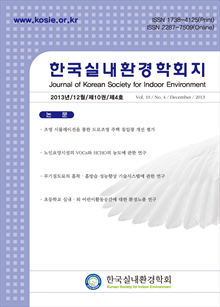간행물
한국실내환경학회지 KCI 등재후보 Journal of Korean Society for Indoor Environment

- 발행기관 한국실내환경학회
- 자료유형 학술지
- 간기 계간
- ISSN 1738-4125 (Print)2287-7509 (Online)
- 수록기간 2004 ~ 2013
- 주제분류 공학 > 환경공학 공학 분류의 다른 간행물
- 십진분류KDC 547DDC 697
권호리스트/논문검색
Vol. 10 No. 1 (2013년 3월) 3건
1.
2013.03
구독 인증기관 무료, 개인회원 유료
This study investigated viability variation of airborne bacteria in indoor environments. The survival in air as a temporal function of bioaerosol viability was reported for Escherichia coli (KCCM 12119, ATCC 11775). Bacteria suspended in distilled water were aerosolized and entered the vertical duct oriented downward. After measurement of number concentration and colony forming unit (CFU) of the bacteria at different locations of the duct, the viability function was calculated. It was found that the bacteria viability(%) decreased with time after aerosolization, 28.454e-0.132x (x:time, min). This study demonstrated the potential application of viability function of airborne bacteria to studies of exposure assessment and infection risk analysis.
4,000원
2.
2013.03
구독 인증기관 무료, 개인회원 유료
As indoor air cleaners have large sizes and high air flow rates, the test methods for particle cleaning capacity need to be reconsidered because the prescribed test chamber size becomes relatively smaller. In this study, air flow rate of air cleaners compared to test chamber size (Q/V) has been investigated by comparing the short-circuit factor which indicates the air mixed condition in the test chamber. The test method of Korea Air Cleaning Association (KACA) has been analysed and compared to that of Association of Home Appliance Manufacturers (AHAM) for clean air delivery rate (CADR) of two household air conditioners equipped with air cleaners having a maximum air flow rate of 15 m3/min in terms of initial particle concentrations, neutralized/non-charged particles, delay time before acquiring initial particle concentration, sampling positions. Constant short-circuit factor of about 0.9 was obtained in the range of Q/V less than 0.73 min-1. CADR based on KACA test method was somewhat dependent on initial particle concentrations, delay time before acquiring initial concentration, sampling positions. However, CADR based on AHAM test method was less dependent. Two or three minutes of delay time before acquiring initial concentration was necessary to reduce the variation of CADR according to initial particle concentration and sampling position.
4,800원
3.
2013.03
구독 인증기관 무료, 개인회원 유료
The objective of this study is to support an environmental policy related to the improved control of indoor airborne fungi in Korea. We reviewed 15 articles published in Korea to analyse the trend of airborne fungi level in indoor environment of various public facilities. The maximum mean concentrations of total airborne fungi in hospital and kindergarten were 1447 CFU/m3 and 1259 CFU/m3, respectively. We concluded that policy determination are urgently required to guide a proper management on airborne fungi in Korea.
4,800원

